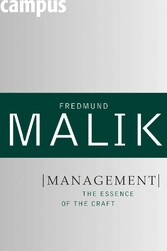
Management - The Essence of the Craft

von: Fredmund Malik
Campus Verlag, 2010
ISBN: 9783593409085
Sprache: Deutsch
304 Seiten, Download: 10617 KB
Format: PDF, auch als Online-Lesen
A Word on the Terms Used (S. 22-23)
In management – as opposed to other, more advanced and mature disciplines of learning – there is no such thing as uniform or common parlance. Quite to the contrary: most authors attempt to impress readers by inventing their own terms and slogans. This is a roadblock to progress and to acquiring management skills. For this book, I essentially draw on the terms used in the St. Gallen Management Model, the fi rst and so far only wholistic, system-driven management model, as well as on the linguistic usage of Peter F. Drucker, the doyen of management theory. As far as cybernetics and system sciences are concerned, I draw on the terms used by Stafford Beer, the originator of management cybernetics, and my own book Strategie des Managements komplexer Systeme [“Strategy for the Management of Complex Systems”].
1. The terms “company”, “organization”, and “institution” are largely used in the same sense. Certain variances in meaning relate to the degree of generality, or the special limitation to a segment of society. The most general terms are “institution” and “organization”. They refer to all organizations existing in a society, no matter what kind or legal form. The term “company”, in essence, belongs to the business sector. When ever no specifi c pointers are provided, it will be clear from the context what I mean when using each of these terms. The term most frequently used in this book is “company” and other terms related to it, such as “corporate policy”. The statements made will generally be applicable to all kinds of institutions. Depending on the fi eld of usage, the terms might need to be adapted somewhat, as in “educational policy” or “health policy”.
2. The term “management” itself can be understood in several ways: Firstly, as a function that exists in any kind of organization and is indispensable for its functioning. This is the so-called functional dimension of management. It is neither linked to specifi c persons nor to organizational elements. This function is not perceptible to our senses. It is incorporated in certain actions taken by individuals and in this way its impact is perceived.
Secondly, the term “management” can be understood to be the sum of the legal and/or organizational authorities in an institution. Examples include the executive board of a private company, the executive committee of a public company, a national government, or a university’s board of directors. This is referred to as the institutional dimension, and it also includes expanded boards of managers, group management, management circles, or partners’ conferences.
As far as mandatory and/ or higher-level authorities are concerned, the respective responsibilities, rights, obligations, and accountabilities are governed by laws, articles of incorporation, or statutes. Those of other organizational entities are determined by common sense and habits. Thirdly, management can be understood to include the persons that belong to the institutional authorities mentioned. This is the personal dimension of management. In particular the terms “top management” and “top manager” frequently carry that meaning."







